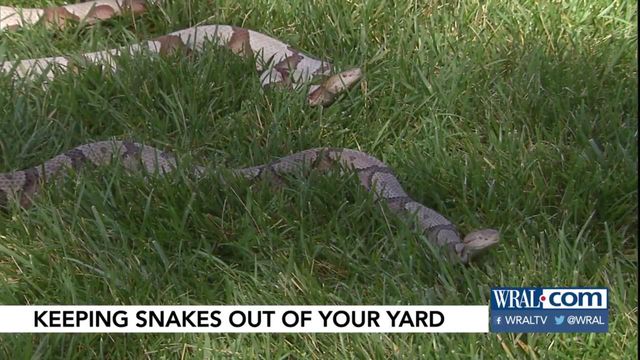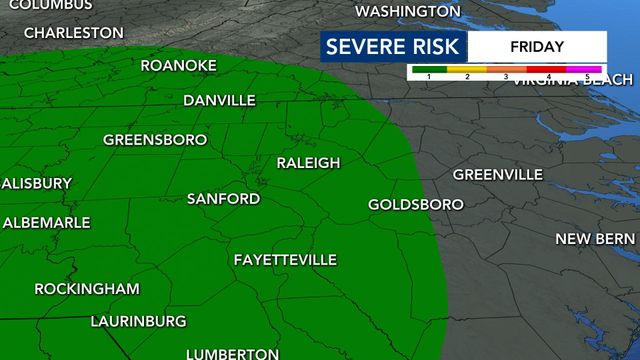How to deal with snakes in your yard safely, sanely and humanely
The spring and upcoming summer season will lead to more time outside, and that means more snake sightings. You can expect to see more snakes showing up along trails, in the woods, crossing roads and in our yards throughout central North Carolina.
The warmer weather means our slithery friends are coming out again.
Snakes in wild spaces are one thing, but those in and around yards, porches and foundations tend to make homeowners a little more uncomfortable. Who knows where else these creepy companions are hiding?
That last word is key when being mindful of our slithery friends. For the most part, snakes are looking to stay out of sight and not trying to intrude on you or your family.
There are nearly 40 species of snakes in North Carolina, many of which are commonly found in residential areas. Such sightings draw a lot of interest, and some of the more highly-read stories on WRAL.com are about people seeing snakes around their home, like one woman in Fayetteville who found three in her apartment.
"What snakes are looking for are mostly places to hide," said Falyn Owens, a biologist with the North Carolina Wildlife Resources Commission. "Snakes need sheltered places where they can feel safe."
This can mean ivy, rocks, tall grass, logs or piles of sticks, as well as gaps and holes in your home's siding and foundation. Seal openings under doors, windows and around water pipes are also opportunities for snakes.
As residential and commercial development continues to grow in North Carolina and more people move to our state, snakes find themselves slithering into neighborhoods and getting a little too close to home for some. Many folks may find that unsettling, but it's important to remember there are methods of getting rid of snakes that are safe for the person and the animal.
Owens shared a few of those tips with WRAL News.
Keep your distance, skip the violence
Wildlife Diversity biologists at the N.C. Wildlife Resources Commission ask that if you see a snake, don't freak out! Do not try to kill the snake. Instead, give it plenty of space.
The first thing Owens wants people to know is that it is not necessary try to hit a snake with a shovel or anything else that snake-haters may feel compelled to do. It's normal to feel scared or creeped out by snakes. But know that snakes – even venomous ones – don't instinctively want to hurt people, so there's no need to try and kill them.
"Even venomous snakes, they don't want to use their venom on anything they can't actually consume," Owens said.
There's also the crucial role that snakes play within the ecosystem that's worth prioritizing over any urge to kill them. Snakes have a utility in our world, and we can certainly coexist.
"Snakes play crucial roles within ecosystems and help control the rodent, slug and insect populations,” said Jeff Hall, a reptile conservation biologist with the Wildlife Commission.
Hall said 10 snake species in North Carolina are listed as endangered, threatened or of special concern.
Getting close enough to injure or kill a snake, Owens pointed out, can put you at risk of getting bitten, and it's not really necessary.
As you'd expect, keeping a safe distance from snakes is the best way to ensure your family's safety.
What to do if you see a pine snake or rattlesnake
If you see a pine snake or rattlesnake, the commission asks you to report it.
Of the six native venomous snake species, three are rattlesnakes – the timber, the pigmy and the Eastern diamondback. Each one is in decline, due mainly to persecution by humans and habitat destruction, and they are protected by the North Carolina Endangered Species Act.
One example of a native threatened, nonvenomous snake species is the Northern pine snake.
Agency biologists want to know more about the distribution of the pine snake, and they are requesting that the public report any sightings.
Pine snake range between 4 and 5 feet long but can get as large as 7-½ feet. They have a white or tan background color with dark brown or black markings that begin as solid coloring or messy blotches near the head before gradually becoming distinct saddle-like blotches toward the tail.
They prefer open areas within pine-oak forests with well-drained, sandy soil and are mostly found in the Sandhills and the southern Coastal Plain, although there are confirmed reports of pine snakes in Cherokee and Swain counties.
"Public assistance in recording and documenting the pine snake will be a huge help because it’s difficult to conserve a species when we don’t know all the places it occurs," said Mike Martin, a wildlife technician with the Wildlife Commission. "We are partnering with several organizations and agencies to conduct surveys in the areas where pine snakes have either been seen or areas with potentially good habitat."
Don’t fall for ‘snake oil’ products
Owens said the products on the market that are marketed as ways to repel snakes are generally labeled "snake oil." She said these can be ignored since research trials have shown these products usually aren't effective.
Don't spend your money on snake deterrent or snake repellent chemicals, especially mothballs, since they can be toxic to wildlife.
Instead, focus on removing the habitat that's attractive to snakes. Keep your grass mowed and avoid areas of brush and tall vegetation to reduce places that snakes can hide.
People can make their yards less desirable for snakes by keeping them free of clutter, including trash, sticks or rock piles, keeping the lawn mowed and closing any gaps in the siding or foundation.
"When somebody's looking for ways to keep snakes away from their yard, reducing those natural hiding places is going to make snakes less comfortable and prey less comfortable," Owens said. "So they're not as likely to be around."
Is relocating a snake a good idea?
There are people who do snake relocations, but Owens said snakes don't tend to do well with relocations.
"The best way we recommend people to deal with a snake in their yard is just wait for a little bit," she said. "If you check back in a couple hours, it's likely to have moved on completely on its own without any help from people."
If you want to hurry a snake along, Owens recommends a light spray with the hose. You can do that at a safe distance, and it doesn't harm the snake. She said it's a fast and effective method that will quickly encourage the snake to find someplace else to go.
See a snake? Report it
If you see a pine snake or rattlesnake, the commission asks you to report it.
Sightings of these snakes in the wild can be reported in one of two ways, via a mobile app or by email. The agency partners with the HerpMapper mobile app to track amphibian and reptile species. Download the app to your mobile device or tablet, and enter information about your sighting. If reporting by email send a photo (required), the date and time the snake was observed and location (GPS coordinates preferred) to pinesnake@ncwildlife.org for Northern pine snakes and to rattlesnake@ncwildlife.org for rattlesnakes.
Most snakes will leave people alone if they aren’t bothered and are provided an escape route. Effective habits for safely co-existing with snakes include watching for snakes and giving them a wide berth. If you see a snake in your yard and would prefer it to reside elsewhere, you can safely encourage it to leave by gently spraying it with a garden hose. To make your yard less hospitable for snakes, clean up clutter such as sticks and rock piles, keep your lawn mowed, close gaps and holes in your siding and foundation, and seal openings under doors, windows and around water pipes.
Keep in mind that some species have similar patterns to Northern pine snakes, especially juvenile rat snakes and racers. For help identifying snake species, visit HerpsofNC.org.
Questions about human-wildlife interactions can be directed to the agency’s NC Wildlife Helpline, Monday through Friday from 8 a.m. to 5 p.m., at 866-318-2401 or by email at HWI@ncwildlife.org.











